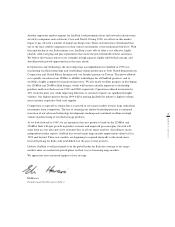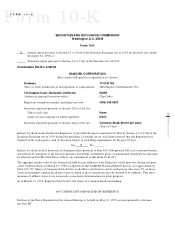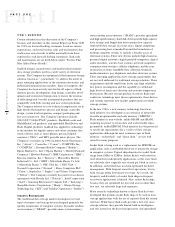SanDisk 1998 Annual Report Download - page 13
Download and view the complete annual report
Please find page 13 of the 1998 SanDisk annual report below. You can navigate through the pages in the report by either clicking on the pages listed below, or by using the keyword search tool below to find specific information within the annual report.
SanDisk Corporation
8
the widespread acceptance of universal industry standards is
important to the development of the market for flash data
storage. The Company designs its products to be compatible
with existing industry standards and, where appropriate,
develops and promotes new standards. The Company was one
of the founding members of PCMCIA, where it has worked
to establish the ATA standard interface which is globally
supported by all PCMCIA card slots. The Company developed
the CompactFlash format and was one of the founding
members of the CompactFlash Association (“CFA”), an
organization established in October 1995 to promote
CompactFlash as a small form factor flash data storage
standard. The Company believes that this format is becoming
the de facto industry standard storage platform for digital
cameras, where it is used instead of traditional film. The
Company’s CompactFlash, FlashDisk, FlashDrive and Flash
ChipSet products are compatible with IDE and ATA standard
interfaces used in all IBM compatible PCs and are compatible
with Windows 95, Windows 98, Windows NT, Windows CE,
Macintosh System 8.0 and other operating systems. The
interoperability afforded by adherence to these industry
standards enables users of flash data storage cards to transfer
data quickly and easily from one device to another, such as
from a digital camera to a desktop computer system
equipped with a PCMCIA or CompactFlash slot.
In November 1997, the Company along with Siemens AG,
introduced the MultiMediaCard format which was designed
to meet the requirements of the mobile communications
industry for a small form factor storage card with a simple
high performance serial interface. The Company is committed
to making MultiMediaCard a broadly supported industry
standard. The Company believes that working with industry
groups to develop widely-adhered-to standards will lead to
the acceptance of the Company’s products in large markets.
The Company is a founding member of the MultiMediaCard
Association.
M aintain Technology Leadership. The Company believes that it
was the first to develop and introduce removable flash data
storage cards and that it has led the industry with several
technological innovations. The Company believes that its
technological expertise in flash memory design and process
engineering, intelligent controllers and system-level integration,
in conjunction with its relationships with its semiconductor
manufacturing partners, provides it with a competitive
advantage. The Company is actively developing advanced
flash data storage technologies designed to enable it to con-
tinue to meet evolving customer requirements for flash data
storage system products. The Company has developed double
density (“D2”) flash, which is a technological innovation
that allows each flash memory cell to store two bits of infor-
mation instead of the traditional single bit per cell, effectively
doubling the amount of storage capacity on approximately
the same size chip. The Company plans to use this technology
to achieve a significant reduction in the cost per megabyte of
flash data storage.
Reduce Cost Per M egabyte of Flash Data Storage. The Company is
focused on reducing the cost per megabyte of its products in
order to increase the number of applications for these products
and to enhance the Company’s ability to address new markets.
The Company has designed its patented flash memory tech-
nology and integrated intelligent controller to increase the
amount of usable flash storage per wafer. The Company
works closely with its manufacturing partners to increase the
amount of storage capacity per wafer by utilizing very small
flash memory cells, to realize high yields through the built-in
ability to utilize partial die and to facilitate the migration to
smaller geometry manufacturing processes through several
generations of flash technology.
Leverage Intellectual Property. The Company has cross-licensed
its flash technology, including its patent portfolio, to selected
third parties. The Company believes that permitting other
flash memory providers to use its technology will facilitate
the development of its target markets, will provide a second
source of supply of CompactFlash, which is required by
many OEM customers, and can serve as a significant source
of license fees and royalty revenues for the Company. To
date, the Company has entered into patent cross-license
agreements with Hitachi, Intel, Samsung, Sharp, SST and
Toshiba, and intends to pursue opportunities to enter into
additional licenses.
Applications and Markets for Flash Data Storage
The Company is targeting the consumer electronics and
the industrial/communications markets for its flash data
storage products.
The Company’s products are used in consumer electronics
applications such as digital cameras, PDAs, highly portable
computers, audio recorders, portable MP3 music players,
video and electronic games, and in industrial/communications
applications such as POS terminals, transportation, medical
instrumentation, automation, telecommunications switches,
PHS base stations, cellular base stations and routers. The
Company’s customers in 1998 included Arrow, Canon,
CompUSA, Kodak, Epson Hanbai, Hewlett-Packard, IBM,
Kyocera, MEI, Mitsubishi Plastic, NEC USA, Norand, Psion,
Staples and Telxon.
Consumer Electronics. The increasing trend towards the use of
digital technology in consumer electronics devices has created
requirements for new data storage products. For example, a
number of major camera and imaging companies have intro-
duced digital cameras that the Company believes will enable
professionals and consumers to eliminate the need for standard
35mm photographic film by replacing it with re-usable compact
digital data storage devices. Removable and embedded flash
data storage products such as the Company’s CompactFlash,
MultiMediaCard and Flash ChipSet products, are used in
PDAs, highly portable computers, digital audio recorders,
network computers, cellular telephones, two-way pagers,
next-generation smart telephones, digital audio samplers and
other devices. These data storage devices need to have a very
























